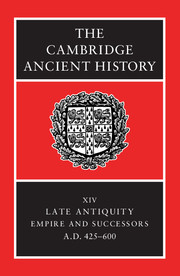Book contents
- Frontmatter
- PART I CHRONOLOGICAL OVERVIEW
- 1 The western empire, 425–76
- 2 The eastern empire: Theodosius to Anastasius
- 3 Justin I and Justinian
- 4 The successors of Justinian
- 5 The western kingdoms
- PART II GOVERNMENT AND INSTITUTIONS
- PART III EAST AND WEST: ECONOMY AND SOCIETY
- PART IV THE PROVINCES AND THE NON-ROMAN WORLD
- PART V RELIGION AND CULTURE
- Conclusion
- Chronological Table
- BIBLIOGRAPHY
- Index
- References
5 - The western kingdoms
from PART I - CHRONOLOGICAL OVERVIEW
Published online by Cambridge University Press: 28 March 2008
- Frontmatter
- PART I CHRONOLOGICAL OVERVIEW
- 1 The western empire, 425–76
- 2 The eastern empire: Theodosius to Anastasius
- 3 Justin I and Justinian
- 4 The successors of Justinian
- 5 The western kingdoms
- PART II GOVERNMENT AND INSTITUTIONS
- PART III EAST AND WEST: ECONOMY AND SOCIETY
- PART IV THE PROVINCES AND THE NON-ROMAN WORLD
- PART V RELIGION AND CULTURE
- Conclusion
- Chronological Table
- BIBLIOGRAPHY
- Index
- References
Summary
GAUL: VISIGOTHIC KINGDOM, 418–507
In 418 the patrician Constantius concluded a peace treaty with the Visigothic king Wallia (415–18), giving him and his following the province of Aquitania Secunda and some adjacent territories to occupy. This completed a process initiated in 416 when Wallia returned his predecessor’s widow, Galla Placidia, to her brother, the emperor Honorius. He had subsequently campaigned for the emperor in Spain, destroying the kingdoms of the Alans and of the Siling Vandals. The nature of the Visigothic presence established in Aquitaine by the treaty of 418 remains controversial. The argument concerns the nature of the process known as hospitalitas. Traditionally, this has been interpreted as involving a major change in land ownership, with the Visigothic ‘guests’ receiving two-thirds of all Roman estates within the designated regions. More recent arguments have seen it as involving not a physical redistribution of land, which would involve large-scale expropriation by the empire of aristocratic property, but a revision of tax obligations, with the Roman landowners having to pay the fiscal burden on two-thirds of their property directly to the designated Visigothic recipients rather than to the imperial administration. According to the view adopted, the Visigoths can be seen in the aftermath of the treaty either as being settled on the land and widely distributed throughout southern Aquitaine or as forming a purely military presence, based on a limited number of urban garrisons.
- Type
- Chapter
- Information
- The Cambridge Ancient History , pp. 112 - 134Publisher: Cambridge University PressPrint publication year: 2001

